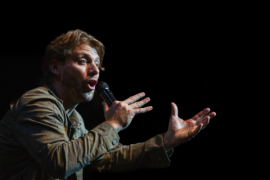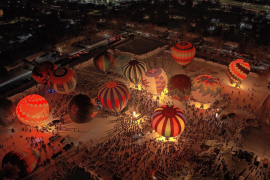It’s not unusual for a laborer to mix and pour concrete, but it’s little more than curious when he or she makes a sculpture—or a cadre of them— instead of paving a driveway. And so, what may begin as a retirement project turns into an obsession—and a way to make a mark on the world.
In Wisconsin, there are several of these unusual “art environments” as they’re called, made by people with no training in sculpture, art or design. Most of these remote installations involve castoff materials.
These environments are on the radar of the Kohler Foundation, a global leader in identifying and preserving this type of artwork. The foundation has placed thousands of these pieces in 300-some nonprofit institutions. Exhibits at the John Michael Kohler Art Center in Sheboygan, routinely focus on this “outsider art,” created everywhere from Wisconsin to India.
“We have been thrilled to see art transforming small towns, revitalizing neighborhoods and motivating people of all ages,” says Christine Taylor, the Kohler Foundation’s executive director. “Art environments are so accessible and easy to relate to, so they tend to have an immediate as well as lasting impact.”
Several art environments are open to the public, and admission is typically free or by donation. Here are some to check out.
Dickeyville Grotto, Dickeyville
Outside of the Holy Ghost Church are biblical and patriotic shrines, completed in 1930 by Father Matthias Wernerus. “God’s wonderful material collected from all parts of the world has been piled up in such a way that it appeals to rich and poor, to educated and uneducated, to men, women and children alike,” he asserted. dickeyvillegrotto.com
Dr. Evermor’s Park, Sumpter
Tom Every, born in 1938, spent a lifetime converting trash to treasure. Next to Delaney’s Surplus on Highway 12, between Sauk City and Baraboo, is his funky zoo of outdoor art, anchored by the 1980s “Forevertron.” It’s 50 feet tall, weighs 300 tons and is billed as the world’s largest scrapyard sculpture. worldofdrevermor.com
Wisconsin Concrete Park, Phillips
Fred Smith, an illiterate lumberjack and farmer who died in 1976, told stories of history and myth through 200-plus sculptures of people and creatures. “Nobody knows why I made them, not even me,” he said long ago. “This work just came to me naturally. I started one day in 1948 …” friendsoffredsmith.org
Grandview, Hollandale
Dairy farmer Nick Engelbert spent over two decades embellishing his yard and farmhouse exterior with dozens of concrete sculptures adorned with repurposed junk. His work began while recovering from a sprained ankle in the 1930s, and the Dickeyville Grotto was an inspiration. Look for the assemblage on Highway 39, between Mineral Point and New Glarus. nicksgrandview.com
The Painted Forest, Valton
On the outside, this little white building looks ordinary. On the inside, walls and ceilings are covered with murals by Ernest Hupeden, a self-taught painter. He worked in exchange for room and board. This 1899 project was for the Modern Woodmen of America, to illustrate the brotherhood’s values and activities. (Viewing hours are limited.) finearts.edgewood.edu/painted-forest
Rudolph Grotto Gardens, Rudolph
While studying for the priesthood in 1912, Father Philip Wagner promised to build a shrine to the Virgin Mary if his poor health improved. The rest is history on five acres of gardens and shrines between Wisconsin Rapids and Stevens Point. Inside the Wonder Cave alone are 26 shrines. Successors finished the project in 1983. rudolphgrotto.org
Jurustic Park, Marshfield
Lawyer Clyde Wynia turned to paleontology upon retirement and decided to assemble his own “Iron Age” menagerie of ancient life, made with recycled industrial materials. Fabric sculptures are a specialty for wife Nancy, a retired nurse. Most everything they make, one mile north of Marshfield, is for sale. jurustic.com
Prairie Moon Sculpture Garden, Cochrane
Farmer Herman Rusch, an immigrant from East Prussia, bought an old dance hall and turned it into a museum of oddities upon retirement. Then he decided the grounds needed personality, so he added more sculptures and built a 260-foot arched, stone fence. He died at age 100 in 1985. kohlerfoundation.org
Tellen Woodland Sculpture Garden, Sheboygan
Woodworker James A. Tellen did detail work at a furniture factory, and his woodcarving hobby during the Depression led to industrial art classes and the creation of 30-some cement statues. See Native Americans, animals, elves and other mythical figures at the family’s vacation cottage in the woodsy Black River neighborhood. Tellen died in 1957. kohlerfoundation.org
Wegner Grotto, Cataract
Paul Wegner, a railroad worker, farmer and garage mechanic, needed a retirement project. So, in 1929 he and wife Matilda began building concrete fences, a prayer garden and more— even an enormous cake, for their 50th wedding anniversary. His funeral in 1937 happened in the property’s little, glass-embellished church. monroecountyhistory.org
For a map and more details about Wisconsin art environments, go to jmkac.org/explore-discover/wandering-wisconsin. For more about ongoing preservation work, check out kohlerfoundation.org/preservation.
This article originally appeared in the 2018 spring/summer issue of Experience Wisconsin magazine. The contents of this article were checked for accuracy when it was published; however, it’s possible some of the information has changed. We recommend you call first if you have specific questions for the destinations, attractions or restaurants mentioned in this article.
No portion of this article or magazine may be reproduced without prior written permission by the publisher.






Comments are closed.